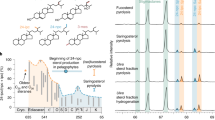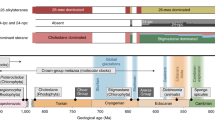Abstract
The Neoproterozoic era (1,000–542 Myr ago) was an era of climatic extremes and biological evolutionary developments culminating in the emergence of animals (Metazoa) and new ecosystems1. Here we show that abundant sedimentary 24-isopropylcholestanes, the hydrocarbon remains of C30 sterols produced by marine demosponges, record the presence of Metazoa in the geological record before the end of the Marinoan glaciation (∼635 Myr ago). These sterane biomarkers are abundant in all formations of the Huqf Supergroup, South Oman Salt Basin, and, based on a new high-precision geochronology2, constitute a continuous 100-Myr-long chemical fossil record of demosponges through the terminal Neoproterozoic and into the Early Cambrian epoch. The demosponge steranes occur in strata that underlie the Marinoan cap carbonate (>635 Myr ago). They currently represent the oldest evidence for animals in the fossil record, and are evidence for animals pre-dating the termination of the Marinoan glaciation. This suggests that shallow shelf waters in some late Cryogenian ocean basins (>635 Myr ago) contained dissolved oxygen in concentrations sufficient to support basal metazoan life at least 100 Myr before the rapid diversification of bilaterians during the Cambrian explosion. Biomarker analysis has yet to reveal any convincing evidence for ancient sponges pre-dating the first globally extensive Neoproterozoic glacial episode (the Sturtian, ∼713 Myr ago in Oman2).
This is a preview of subscription content, access via your institution
Access options
Subscribe to this journal
Receive 51 print issues and online access
$199.00 per year
only $3.90 per issue
Buy this article
- Purchase on Springer Link
- Instant access to full article PDF
Prices may be subject to local taxes which are calculated during checkout


Similar content being viewed by others
References
Peterson, K. J., Cotton, J. A., Gehling, J. G. & Pisani, D. The Ediacaran emergence of bilaterians: Congruence between the genetic and the geological fossil records. Phil. Trans. R. Soc. B 363, 1435–1443 (2008)
Bowring, S. A. et al. Geochronologic constraints on the chronostratigraphic framework of the Neoproterozoic Huqf Supergroup, Sultanate of Oman. Am. J. Sci. 307, 1097–1145 (2007)
Fike, D. A., Grotzinger, J. P., Pratt, L. M. & Summons, R. E. Oxidation of the Ediacaran ocean. Nature 444, 744–747 (2006)
McCarron, G. The Sedimentology and Chemostratigraphy of the Nafun Group, Huqf Supergroup, Oman. Thesis, Univ. Oxford (2000)
Grantham, P. J., Lijmbach, J., Posthuma, J., Hughes Clarke, M. W. & Willink, R. J. Origin of crude oils in Oman. J. Petrol. Geol. 11, 61–80 (1988)
Höld, I. M., Schouten, S., Jellema, J. & Sinninghe Damste, J. S. Origin of free and bound mid-chain methyl alkanes in oils, bitumens and kerogens of the marine, Infracambrian Huqf Formation (Oman). Org. Geochem. 30, 1411–1428 (1999)
Love, G. D., Snape, C. E., Carr, A. D. & Houghton, R. C. Release of covalently-bound biomarkers in high yields from kerogen via catalytic hydropyrolysis. Org. Geochem. 23, 981–986 (1995)
Murray, I. P., Love, G. D., Snape, C. E. & Bailey, N. J. L. Comparison of covalently-bound aliphatic biomarkers released via hydropyrolysis with their solvent-extractable counterparts for a suite of Kimmeridge clays. Org. Geochem. 29, 1487–1505 (1998)
Brocks, J. J. et al. Biomarker evidence for green and purple sulphur bacteria in a stratified Palaeoproterozoic sea. Nature 437, 866–870 (2005)
Summons, R. E., Jahnke, L. L., Hope, J. M. & Logan, G. A. 2-Methylhopanoids as biomarkers for cyanobacterial oxygenic photosynthesis. Nature 400, 554–556 (1999)
Volkman, J. K. Sterols in microorganisms. Appl. Microbiol. Biotechnol. 60, 495–506 (2003)
Moldowan, J. M. et al. Sedimentary 24-n-propylcholestanes, molecular fossils diagnostic of marine algae. Science 247, 309–312 (1990)
Bergquist, P. R., Hofheinz, W. & Oesterhelt, G. Sterol composition and classification of the Demospongiae. Biochem. Syst. Ecol. 8, 423–435 (1980)
Silva, C. J., Wunsche, L. & Djerassi, C. Biosynthetic studies of marine lipids 35. The demonstration of de novo sterol biosynthesis in sponges using radiolabelled isoprenoid precursors. Comp. Biochem. Physiol. B 99, 763–773 (1991)
McCaffrey, M. A. et al. Paleoenvironmental implications of novel C30 steranes in Precambrian to Cenozoic age petroleum and bitumen. Geochim. Cosmochim. Acta 58, 529–532 (1994)
Kodner, R. B., Summons, R. E., Pearson, A., King, N. & Knoll, A. H. Sterols in a unicellular relative of the metazoans. Proc. Natl Acad. Sci. USA 105, 9897–9902 (2008)
Narbonne, G. M. & Gehling, J. G. Life after snowball: The oldest complex Ediacaran fossils. Geology 31, 27–30 (2003)
Droser, M. L., Jensen, S. & Gehling, J. G. Trace fossils and substrates of the terminal Proterozoic-Cambrian transition: Implications for the record of early bilaterians and sediment mixing. Proc. Natl Acad. Sci. USA 99, 12572–12576 (2002)
Yin, L. et al. Doushantuo embryos preserved inside diapause egg cysts. Nature 446, 661–663 (2007)
Gehling, J. G. & Rigby, J. K. Long expected sponges from the Neoproterozoic Ediacaran fauna of South Australia. J. Paleontol. 70, 185–195 (1996)
Brasier, M., Green, O. & Shields, G. Ediacarian sponge spicule clusters from southwestern Mongolia and the origins of the Cambrian fauna. Geology 25, 303–306 (1997)
Li, C. W., Chen, J. Y. & Hua, T. E. Precambrian sponges with cellular structures. Science 279, 879–882 (1998)
Xiao, S., Zhang, Y. & Knoll, A. H. Three-dimensional preservation of algae and animal embryos in a Neoproterozoic phosphorite. Nature 391, 553–558 (1998)
Sperling, E. A., Peterson, K. J. & Pisani, D. in The Rise and Fall of the Ediacaran Biota (eds Vickers-Rich, P. & Komarower, P.) 355–368 (Geological Society Special Publications, 2007)
Peterson, K. J. et al. Estimating metazoan divergence times with a molecular clock. Proc. Natl Acad. Sci. USA 101, 6536–6541 (2004)
Peterson, K. J. & Butterfield, N. J. Origin of the Eumetazoa: Testing ecological predictions of molecular clocks against the Proterozoic fossil record. Proc. Natl Acad. Sci. USA 102, 9547–9552 (2005)
Thiel, V. et al. A chemical view of the most ancient metazoa – biomarker chemotaxonomy of hexactinellid sponges. Naturwissenschaften 89, 60–66 (2002)
Bergquist, P. R., Karuso, P., Cambie, R. C. & Smith, D. J. Sterol composition and classification of the Porifera. Biochem. Syst. Ecol. 19, 17–24 (1991)
Rothman, D. H., Hayes, J. M. & Summons, R. E. Dynamics of the Neoproterozoic carbon cycle. Proc. Natl Acad. Sci. USA 100, 8124–8129 (2003)
McFadden, K. A. et al. Pulsed oxidation and biological evolution in the Ediacaran ocean. Proc. Natl Acad. Sci. USA 105, 3197–3202 (2008)
Acknowledgements
Funding support for this work came from Petroleum Development Oman (PDO), the NASA Exobiology Program, the NSF EAR Program, the Agouron Institute and the NASA Astrobiology Institute. We thank PDO for access to sample materials and Z. Rawahi and P. Taylor, in particular, for their input. C. Colonero, R. Kayser and A. Lewis provided laboratory assistance, including the maintenance of mass spectrometers at MIT.
Author Contributions G.D.L. interpreted the data and wrote the manuscript with input from R.E.S, D.A.F, A.S.B and E.G. G.D.L., E.G., C.S. and A.E.K. acquired the Huqf biomarker data working in the research group of R.E.S. A.S.B. and M.B. screened extant demosponges for their sterol contents. C.E.S. and W.M. made facilities available for HyPy experiments on kerogens and trained C.S. to use the equipment. J.P.G. provided a robust stratigraphic framework for the Huqf Supergroup in the SOSB and with D.A.F. identified key sedimentary rock samples to use in this investigation. S.A.B and D.J.C. measured important U–Pb ages for ash beds and detritral zircons through the stratigraphy to constrain the age range and distribution of our demosponge biomarkers.
Author information
Authors and Affiliations
Corresponding author
Supplementary information
Supplementary Information
This file contains Supplementary Data, Supplementary Figure 1 with Legend, Supplementary Tables 1-4, Supplementary Results, a Supplementary Discussion and Supplementary References (PDF 1699 kb)
PowerPoint slides
Rights and permissions
About this article
Cite this article
Love, G., Grosjean, E., Stalvies, C. et al. Fossil steroids record the appearance of Demospongiae during the Cryogenian period. Nature 457, 718–721 (2009). https://doi.org/10.1038/nature07673
Received:
Accepted:
Issue Date:
DOI: https://doi.org/10.1038/nature07673
This article is cited by
-
Molecular fossils in reefal carbonates and sponges of the deep fore reef of Mayotte and Mohéli, Comoro Islands, western Indian Ocean
Facies (2024)
-
Sulfur, sterol and trehalose metabolism in the deep-sea hydrocarbon seep tubeworm Lamellibrachia luymesi
BMC Genomics (2023)
-
Common origin of sterol biosynthesis points to a feeding strategy shift in Neoproterozoic animals
Nature Communications (2023)
-
Mid-latitudinal habitable environment for marine eukaryotes during the waning stage of the Marinoan snowball glaciation
Nature Communications (2023)
-
Sterol methyltransferases in uncultured bacteria complicate eukaryotic biomarker interpretations
Nature Communications (2023)
Comments
By submitting a comment you agree to abide by our Terms and Community Guidelines. If you find something abusive or that does not comply with our terms or guidelines please flag it as inappropriate.



